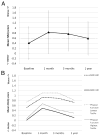Evaluating the association of preoperative functional status and postoperative functional decline in older patients undergoing major surgery
- PMID: 23265122
- PMCID: PMC4241019
Evaluating the association of preoperative functional status and postoperative functional decline in older patients undergoing major surgery
Abstract
This prospective cohort study sought to identify predictors of functional decline in patients aged 65 years or older who underwent major, nonemergent abdominal or thoracic surgery in our tertiary hospital from 2006 to 2008. We used the Stanford Health Assessment Questionnaire-Disability Index (HAQ-DI) to evaluate functional decline; a 0.1 or greater increase was used to indicate a clinically significant decline. The preoperative Duke Activity Status Index (DASI) and a physical function score (PFS), assessing gait speed, grip strength, balance, and standing speed, were evaluated as predictors of decline. We enrolled 215 patients (71.2 ± 5.2 years; 56.7% female); 204 completed follow-up HAQ assessments (71.1 ± 5.3 years; 57.8% female). A significant number of patients had functional decline out to 1 year. Postoperative HAQ-DI increases of 0.1 or greater occurred in 45.3 per cent at 1 month, 30.1 per cent at 3 months, and 28.3 per cent at 1 year. Preoperative DASI and PFS scores were not predictors of functional decline. Male sex at 1 month (odds ratio [OR], 3.05; 95% confidence interval [CI], 1.41 to 6.85); American Society of Anesthesiologists class (OR, 3.41; 95% CI, 1.31 to 8.86), smoking (OR, 3.15; 95% CI, 1.27 to 7.85), and length of stay (OR, 1.09; 95% CI, 1.01 to 1.16) at 3 months; and cancer diagnosis at 1 year (OR, 2.6; 95% CI, 1.14 to 5.96) were associated with functional decline.
Figures


Similar articles
-
Integration of the Duke Activity Status Index into preoperative risk evaluation: a multicentre prospective cohort study.Br J Anaesth. 2020 Mar;124(3):261-270. doi: 10.1016/j.bja.2019.11.025. Epub 2019 Dec 19. Br J Anaesth. 2020. PMID: 31864719
-
Evaluation of Postoperative Functional Health Status Decline Among Older Adults.JAMA Surg. 2020 Oct 1;155(10):950-958. doi: 10.1001/jamasurg.2020.2853. JAMA Surg. 2020. PMID: 32822459 Free PMC article.
-
Effect of anaemia on hand grip strength, walking speed, functionality and 1 year mortality in older hospitalized patients.BMC Geriatr. 2016 Aug 19;16(1):153. doi: 10.1186/s12877-016-0326-y. BMC Geriatr. 2016. PMID: 27543049 Free PMC article.
-
Preoperative geriatric assessment and follow-up of patients older than 75 years undergoing elective surgery for suspected colorectal cancer.J Geriatr Oncol. 2019 Sep;10(5):709-715. doi: 10.1016/j.jgo.2019.01.020. Epub 2019 Feb 8. J Geriatr Oncol. 2019. PMID: 30745117
-
Functional independence after major abdominal surgery in the elderly.J Am Coll Surg. 2004 Nov;199(5):762-72. doi: 10.1016/j.jamcollsurg.2004.05.280. J Am Coll Surg. 2004. PMID: 15501119
Cited by
-
Long-term Functional Decline After High-Risk Elective Colorectal Surgery in Older Adults.Dis Colon Rectum. 2020 Jan;63(1):75-83. doi: 10.1097/DCR.0000000000001541. Dis Colon Rectum. 2020. PMID: 31804270 Free PMC article.
-
Ability of preoperative falls to predict postsurgical outcomes in non-selected patients undergoing elective surgery at an academic medical centre: protocol for a prospective cohort study.BMJ Open. 2016 Sep 21;6(9):e011570. doi: 10.1136/bmjopen-2016-011570. BMJ Open. 2016. PMID: 27655260 Free PMC article.
-
Measurement properties of the Human Activity Profile questionnaire in hospitalized patients.Braz J Phys Ther. 2017 May-Jun;21(3):153-158. doi: 10.1016/j.bjpt.2017.03.011. Epub 2017 Apr 9. Braz J Phys Ther. 2017. PMID: 28473282 Free PMC article.
-
Functional Trajectories Before and After Major Surgery in Older Adults.Ann Surg. 2018 Dec;268(6):911-917. doi: 10.1097/SLA.0000000000002659. Ann Surg. 2018. PMID: 29356710 Free PMC article.
-
Laparoscopic Gastric Gastrointestinal Stromal Tumor (GIST) Resection in a 108-Year-Old Patient.Cureus. 2025 Mar 25;17(3):e81146. doi: 10.7759/cureus.81146. eCollection 2025 Mar. Cureus. 2025. PMID: 40276399 Free PMC article.
References
-
- National Center for Health Statistics, Centers for Disease Control and Prevention. [Accessed November 11, 2010]; Available at: www.cdc.gov/nchs.
-
- Thomas DR, Ritchie CS. Preoperative assessment of older adults. J Am Geriatr Soc. 1995;43:811–21. - PubMed
-
- Stamou SC, Dangas G, Dullum MK, et al. Beating heart surgery in octogenarians: perioperative outcome and comparison with younger age groups. Ann Thorac Surg. 2000;69:1140–5. - PubMed
-
- Kirchhoff P, Dincler S, Buchmann P. A multivariate analysis of potential risk factors for intra- and postoperative complications in 1316 elective laparoscopic colorectal procedures. Ann Surg. 2008;248:259–65. - PubMed
-
- Finlayson EV, Birkmeyer JD. Operative mortality with elective surgery in older adults. Eff Clin Pract. 2001;4:172–7. - PubMed
